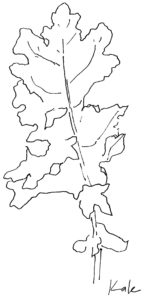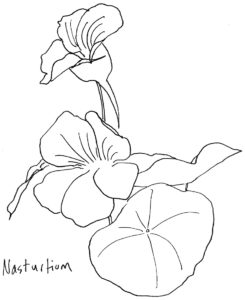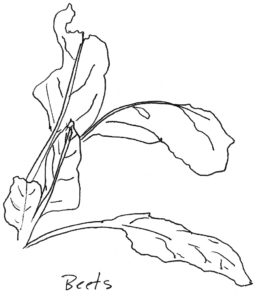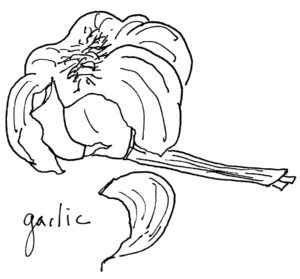Text and Drawings by Abraham Storer

Sarah Naciri runs Sustainable CAPE’s Community Children’s Garden at the Truro Public Library, where she leads children in planting, cultivating, and harvesting vegetables. Last week, while she worked with volunteer Mimi Bois and a few children, she described the crops they’re still harvesting and planting.
Q: What’s growing in your garden right now?
Sarah Naciri: We’re continuing to eat the kale that’s growing new. We’re also harvesting squash and beets, and we have lots of chives, a variety of herbs, and nasturtiums.
Q: Are you planting anything?
SN: In August, we planted carrot seeds and beet seeds with the hope that we would get a fall crop. Some of the beets have really taken off. We’re now transplanting the seedlings to larger beds. At some point when it gets really cold we will cover these up with a row cover called Reemay — a light fabric that can be placed over cold-sensitive plants to protect them from cold temperatures. We’ll probably get some small crops in November.

Next week we’re planning on planting a good amount of garlic. We usually do 60 to 70 garlic plants in the children’s garden.
Q: How do you grow garlic?
SN: I save seed garlic — bulbs from the biggest, healthiest bulbs we grow. I also always get some from a few other farms so that we’re not just using the same varieties year after year. Throughout the summer when people are harvesting their garlic, I try to get in quickly to get the most beautiful cloves. I cure them at home — I choose a dark, dry place and use fans to really keep the air flowing and get it dry. It takes a few weeks to cure it properly, and once it’s dried it stores well.
Q: And then you just put the cloves in the soil?

SN: It’s important to enrich the spot where you’re growing garlic. Before I plant, I like to amend the soil with a powdered blend of sulfur, alfalfa meal, bone char, zeolites, feather meal, and neem cake. This will hopefully bring bigger bulbs and richer flavor.
The kids break the cured bulbs into cloves and then we will plant each clove, placing the root end down and the pointed tip upward. They should be planted two inches deep and six inches apart in rows 15 to 18 inches apart. After planting, we add a thick layer of salt marsh hay or straw to keep the garlic happy throughout the winter. In the spring, we very slowly and carefully take off the salt hay, layer by layer, as the ground warms.
Q: Do you enrich the rest of the garden soil at this time of year?
SN: AmeriCorps helps us collect seaweed, which we use to put the beds to rest. There are years and years of seaweed here. We also put in layers of leaf mulch, and we’ve used little bits of manure at different times.
